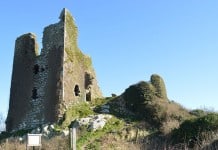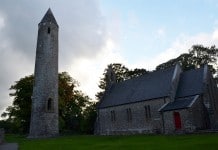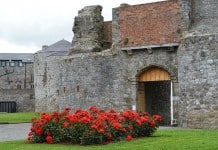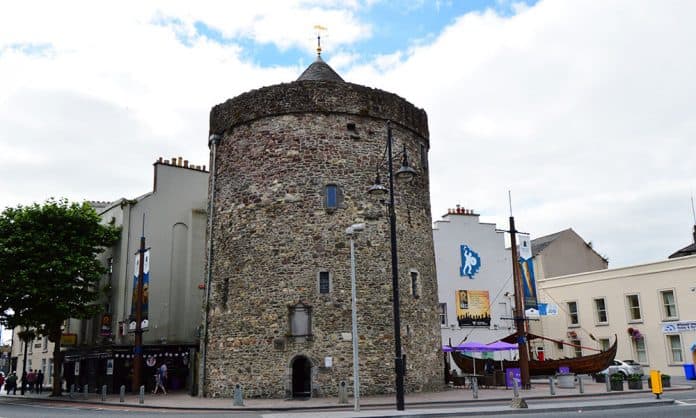
Reginald’s Tower has dominated the east end of Waterford’s pretty city quay for centuries. It was constructed as part of the defensive wall that ringed the city. It has been used for multiple purposes at various points through the hundreds of years since it was first erected – as a mint, as a prison and even as a store for arms. Famous names associated with the tower include the Normans, Vikings, Strongbow and Oliver Cromwell, among many other to numerable to name.
The History of Reginald’s Tower
Reginald’s Tower takes its name from Ragnall (Reginald) MacGillemaire, a key leader of the Irish Vikings, who was held as a prisoner in the tower by the Anglo-Normans. It would become the setting for the landmark marriage between Richard ‘Strongbow’ de Clare (the Second Earl of Pembroke) and Aoife, the daughter of the King of Leinster. This was a marriage that would irrevocably change the course of the history of Ireland. Later, the sacking of the tower by Cromwell and his men would mark a pivotal point in the tower’s history.
Waterford’s Viking History
Norman invaders attacked the city in 1170. They immediately recognized the merit of the tower (the positioning was highly strategic, being on high ground between two rivers and a stone’s throw from the ancient French Church), and it was its sacking that was the catalyst that led to the fall of the city. It is the only structure in all Ireland that has a Viking name.
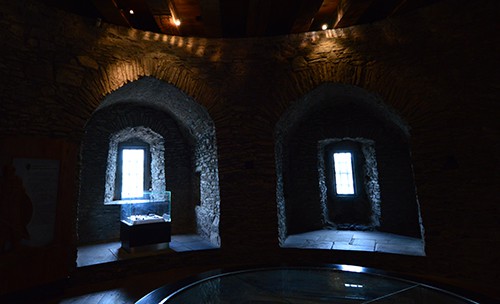
Norman Stone
Though the original tower (constructed in 1003) was made from wood, this was later replaced with stone. While it was unusual for Norsemen to utilise stone as their primary building material, recent archaeological excavations have indicated that quite a number of the defences in the city were made from stone prior to 1170 (the year of the Norman invasion). While the exact date the stone construction is not known, it is likely that it was at some point in the latter half of the 12th century. In 1185 an English prince, John, arrived in Waterford and set about rebuilding and improving the defences of the city – of which the tower was a key part.
The ‘Viking Triangle’
The tower stands 54 feet high and has a diameter of 42.5 feet. Its roof is cone-shaped, and within the sturdy walls there is a spiral staircase that ascends to the top. It sits within what’s known as the ‘Viking Triangle’ – the location of Reginald’s Tower being one of three significant structures (the other two being St. Martin’s Castle and the Turgesius Tower), which, when marked on a map, form a triangle shape.
Waterford’s Largest Tower
Today it holds the honour of being the largest of the six surviving defence towers in County Waterford, with the others being the Watch Tower, the Double Tower, the French Tower, the Beach Tower and the Semi-Lunar Tower.
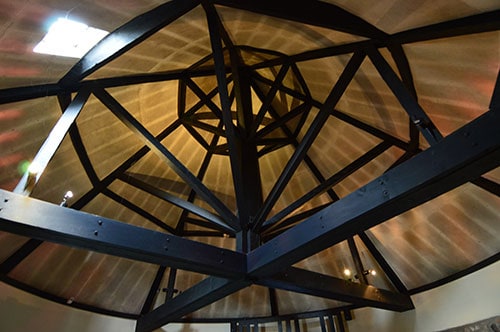
Royal Patronage Across the Ages
From time to time the tower was used as a royal castle. King John was among its first regal visitors in 1210, and while there he ordered that new coins should be stuck. Richard II, who visited in 1394 and 1399, used the it as a place to store his collection of munitions. When he departed the tower in 1399, he left as King of England and Wales; as soon as he arrived in England, he was captured by the man who would later be Henry IV and forced to declare his abdication. It is said that 1690, shortly after his troops were confounded at the Battle of the Boyne, the English King James II climbed right up to the top of the tower so that he could survey his lost lands before setting off for his exile in France.
Civitas Waterford
In 1463, new coins began to be minted at the tower following orders from the Irish Parliament, who were convening in Waterford at that time. The distinctive coins had the phrase “Civitas Waterford” on one side.
Waterford, the Unconquered City
In 1495, the tower underwent an ultimately unsuccessful attack by Perkin Walbeck (the pretender to the throne of the incumbent Henry VII) and his men. The cannons were used to great success, sinking one of the attacking ships during a siege that lasted eleven full days. This is significant because it was the first time any Irish city had successfully employed artillery. This great victory led to the city of Waterford acquiring a new motto: ‘Urbs Intacta Manet’, which translates as ‘Waterford remains the unconquered city’.
Civil War
Slightly less than two centuries later, it fell to Old Ironsides to disprove this motto, when he and his men successfully sacked the city in 1650, following an abortive attempt the year before. The cannonball that is to this day lodged in the tower’s north side is believed to have been from this siege.
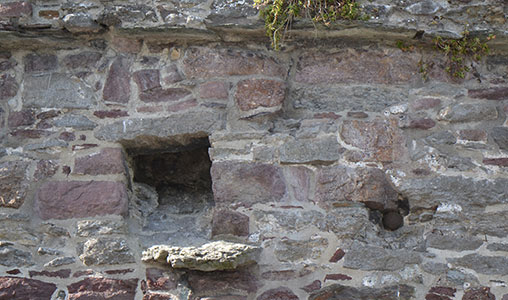
More Recent Times
Long after the days of the Vikings, Normans and Strongbow, and post-Cromwell, Reginald’s Tower was mainly used for the storage of munitions. In the early nineteenth century, it became a prison. Reginald’s Tower fell under the auspices of the Waterford Corporation in 1861, and it became the residence of the Chief Constable of the city. It was continuously inhabited right up to 1954, when the last tenant left and the tower was then reconfigured into a museum. Throughout the Emergency (in World War II), it was used as an air raid shelter.
Present Day
Today, Reginald’s Tower is home to the Waterford Viking Museum, where you will find fascinating and well-curated exhibits covering its history, including the Normans and famous figures such as Strongbow and Cromwell. Among the artefacts are those discovered during a dig at nearby Woodstown by the River Suir in 2003.
Visiting Reginald’s Tower Waterford
Parking is available within easy walking distance with the Bolton Street Public Car Park being about 3 minutes’ walk away. On street parking is also available in the area.
An average visit lasts for approximately 60 minutes, with last admissions being 30 minutes before closing.
The taking of photographs and video is permitted. On the top floor there is an audio-visual presentation available that presents the history of Reginald’s Tower.
Opening Times
As of September 2016 the opening times are from January through to Early March: Wednesday – Sunday – 9.30 – 17.00; Late March until Mid-December: Daily – 9.30 – 17.30. It is closed for Christmas from the 24th December until the 6th January inclusive.
Ticket prices:
Adult: €4, Senior/Group: €3, Child/Student: €2, Family: €10
Please be aware that access is limited to the ground floor for people with mobility disabilities.

